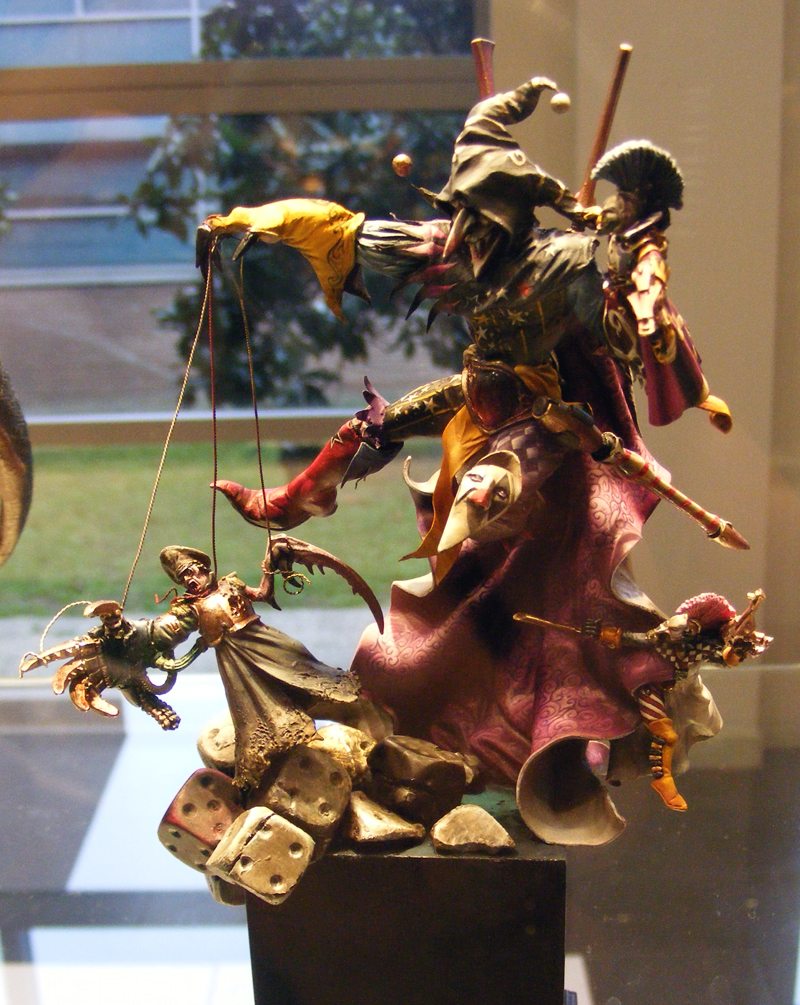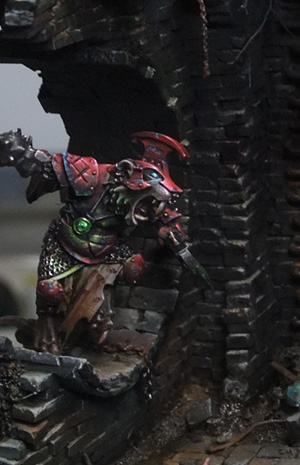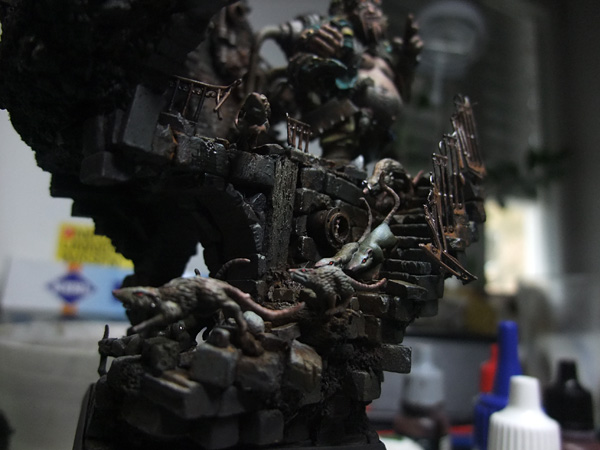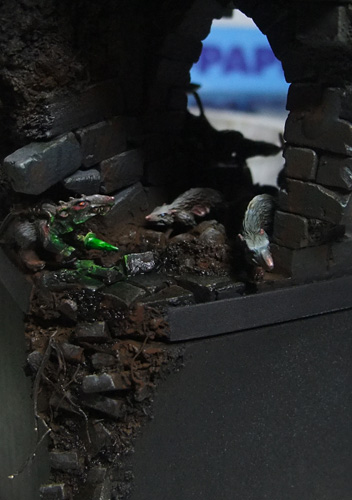I took many pictures during the Ork Nob creation process. This article will tell you in detail every step carried out to create this figure.
First, I took several pieces of 40k Ork at hand, and began to investigate as if it were a puzzle to come up with something that would convince me. This is the first version I composed (completely different from what it turned out at the end, but you need to see this step to understand the whole process).





After this first version, I talked a lot with my colleagues on how to improve it. After a productive afternoon of painting in our personal painting temple in Madrid (TWT) and a night at my good friend Elias Alonso’s, this was the result:

Once I cleared out the pose, the front view convinced me greatly. I made the base with varied pieces of plaster as ruins:






At this point I undercoated the figure, without gluing the arm with the axe, the head nor the banner:

And here I started to paint. I used a basic mixture of Scorpion Green (GW) and Chocolate Brown (Vallejo) lighted up with Ice Yellow (Vallejo), and introducing some Clear Sand (Vallejo), shadowed with Oxford Blue and Brown (Vallejo).



Then I got to the pants. I used a mixture of English Uniform (Vallejo) with some Yellow Green (Vallejo) or Scorpion Green, lighted up with Ice Yellow and shadowed with Oxford Blue and some red more pronounced in the deepest shadows. The truth is that I was not happy with the colour and I finally started to use tones of other colours and it changed a lot. In any case this was the first approach:




As you can see in the pictures above and also in these which I put now, I decided to remove the covers of the holsters that come with the standard because it made it even bigger, and partially blocked the leather pants which did not want to lose. Also, the covers did not convince me too much. I made this homemade solution with a brass tube, cutting the banner with the Dremmel and sanding the end of the joint for the banner to fit inside the tube.



The one reason why I finally decided to remove the holsters was the leather jacket back where I wanted to paint some good leather. I started with Chocolate brown, English Uniform and Bestial Brown (GW) with Ice Yellow for the lights shadowed down to almost pure black:



I had already decided to use yellow for the armour plates and I knew it was going to distract attention from a much more important detail: the face. Thus, making use of red, I devised a composition in a cross shape around the face to frame it. Therefore the red, apart from distracting from the yellow, directs the viewer to the face. You will see in the end that these points are the only reds in the figure. I took a picture of the Ork and marked with crosses the points where the reds would be placed. In the banner and the weapons and it was clear that I would use bloodstains. On the floor it was not so clear, so I decided to introduce a Cadian helmet. At first I thought I'd paint it any colour and then introduce blood as well but I thought it would be too much gore for the miniature and that bloodstains would seem too strategically placed, too unnatural. So I chose to paint the helmet in red. The following is the photo in which I make the composition study:

And from another angle:

Once it became clear to me, I began to paint the other arm:





In these pictures it seems a little dirty but I would clean it later.
Here's how I made the shoulder pads. Following a tutorial by Allan Carrasco, I used a base coat of Sunburst Yellow (GW), and while each layer was drying (a yellow base is hard to paint, you have to give several coats to cover well) I painted in black the chest areas which were to be painted in metal:



Over the base layer we paint lights and shadows. I did the opposite of what should be done and I skipped this step. I did it afterwards, but it would have been desirable to do so now.
Then I did some Ork style freehands, which are not complicated at all. First I defined more or less the shape (it's a very simple one which makes the job easier):

As it convinces me, I fill the picture completely. If I were not convinced, since the initial shape is very light, I can erase it by painting over the basic tone of the pad and then change it later:

I paint the other pad with the same process:


Then I give lights and shadows to the whole set of shoulder pads and freehands. Therefore we blend the drawings with the shoulder pads and everything looks more integrated with the dirt and wear of the set. I insist that I did this after I made the paint chips, but it is advisable to follow the steps I said.
Now we proceed with the chipping. I followed again the tutorial by Allan Carrasco, very simple. We take Boltgun Metal (GW) and with a fine brush (I used Windwor & Newton 00) we mark the metal peeled areas. It is important to note that they have to be random, putting more chips around the edges, where it makes sense that the material has weared more. It is also useful to bring out bigger chipped areas as if they had jumped because of a blow or an impact and other areas with virtually no chipping.
Then you have to paint the lights and shadows of the chipped paint. We will simulate the paint discontinuity when the paint has been stripped off. To do this, you have to paint the lights in the areas that face light and mark the shadow mark on the lower parts of the color changes, where the shadow would really appear, to get real look of peeled paint. I’ll show you an outline of what I want to explain:
First base and chips:

After the lights and shadows of chipping:

And then a touch of Mithril Silver in areas where there is more metal to give more realism:

That's how the figure looks like:







After that, I used glazes of red and brown for the chest plates to improve their appearance. This was not very important because the face will cover them almost entirely.

After I started with the leathers, with Brown Chocolate, English Uniform, Reddish Brown (Andrea)... I basicly made a brown palette with all I had at hand.






Meanwhile I painted the weapons in black. Here I also painted the metal plate in his hand, and the boots. The metals are fairly easy and grateful to paint. The base layer is Boltgun Metal, lighted up with Mithril Silver and final lights with Metallic Medium (Vallejo). I made the shadows with matte colours, mostly yellow and brown as the ones I had used in the rest of the miniature to maintain some consistency.








Here I begin to paint the face. From the first images to how it turned out in the end there is quite a distance, which is interesting to see how the figure evolves and how important the finishing touches are. First, basic lights and shadows for the face using the same skin tones lighted with Ice Yellow. For the mouth I used pinkish colours like the ones for the lip. The teeth are just a base coat of English Uniform with Ice Yellow. I should have used Bleached Bone (GW) but I hadn’t got any so I created it by mixing other colours.




Principio del formulario
Escribe texto o la dirección de un sitio web o traduce un documento.
Cancelar
Escuchar
Final del formulario
In the next step paint the left arm axe completely. The lifted axe has Boltgun Metal base layer. The axe is simply a metal job, always pushing lights to Mithril and Metallic Medium in the end. In addition, I experimented with different colours for the shadows and oxides without a specific recipe. It is simply a matter of playing with colours and trying. I also tried not to let everything in silver and in some areas I used Tin Bitz (GW) as a base, mixing it with Boltgun Metal or Mithril. In these steps I also used some strange oxides with turquoise but then took them out because they combined badly with the green skin, so I finally opted for more conventional orange ochres. I respected the palette of yellows and browns used in the pads to give homogeneity.
As for the face, I defined the mouth darkening with dark browns, I painted the teeth and lips with a pink that is made from Magenta (Vallejo). Then there are some early skin tones with different reds and blues taken from what I had in the palette, not too complicated. If you stick to a few colours you'll achieve greater colour harmony and atmosphere without even noticing.



Then I placed the banner with his fist already painted. The process is the same as what I did with the shoulder pads. I also started painting the raised axe. The quality of that piece is much lower than the other arm, because it's from a plastic Ork and in this case it makes a great difference in all aspects, especially when painting. It costed me a lot of effort and the result is much worse. As the axe was big and I did not want to leave too much metal together, I decided that some areas were also going to be painted in the scratched yellow from the pads and the banner. That would give more harmony beacuse the yellow would be distributed more over all the miniature. What worried me initially was that the yellow was highly dispersed at the top of the miniature, and ate the other colours by catching all the viewer’s attention. I had in mind to solve this with the bloodstains that I explained above and as you will see the end, that’s what I did.
I also tried some kind of red light effect on the cross of the bionic eye but that did not convince me. I also worked the metals in the top of the banner with glazes of red, Scab Red (GW) and the like, to give a bit of intensity to the figure.






Since the contest in which I would enter the figure (Golden Demon Spain 2008) was very close I could not take pictures of the process so often and I have got only the ones just before leaving for Barcelona.
In this next step I did the blood stains (discussed in the photo of the red crosses composition) and painted the base. Blood stains are simply a game of dotting and making stripes more or less studied with many types of red. You have to play with the brightness and gloss of paints and varnishes, ensuring that the inside of the stains keeps a much darker red, black in some parts to make it a bit more gore.
The base is also a fun part of painting. First I painted all in a brown tone with acrylics and then with oils, staining and staining until I liked the result. It is a very fun game that I recommend. It does not have a specific recipe, the only secret is to try colours, doing and re-doing until one is satisfied with the result.
As I said, the part of the composition cross which was on the base, instead of putting blood I thought it was best to put a Cadian helmet painted in red not to fill all with blood.
And that's how I left the miniature before travelling. There are things unfinished, such as the raised hand axe and the hair tufts of the banner, which are based simply on base colour.






Just before travelling and since I had been going over the idea along the whole process, I decided to destroy the bionic eye and put a lens. I think it was a very wise decision if somewhat risky for the time I did it. It was not very difficult but dangerous, all I did was put a ball of putty covering the cross and then paint it. At first I thought to use Dremmel to the cross but I'm glad I didn’t because the risk was too great. Who knows what could have happened...
Already in Barcelona and with the help of my great master Banshee, I finished all the things remaining. These were the tufts and the hand basically, and from there we made the famous final touches which are what give a miniature the quality raise. Mainly this consisted of contrasting the points of light in the face, giving gloss to the lip, improving blood stains by giving a touch of magenta and black inks, repainting some areas of the leathers that were pretty bad, painting some skin cuts, changing the colour to the eyecup, mouth shaping contrasting with very dark colours ... I listed about 20 things to finish off the figure and right now I do not remember them all, but the truth is that I painted and painted until I fell asleep.
And this is the final result that you have already seen!






















































































































































